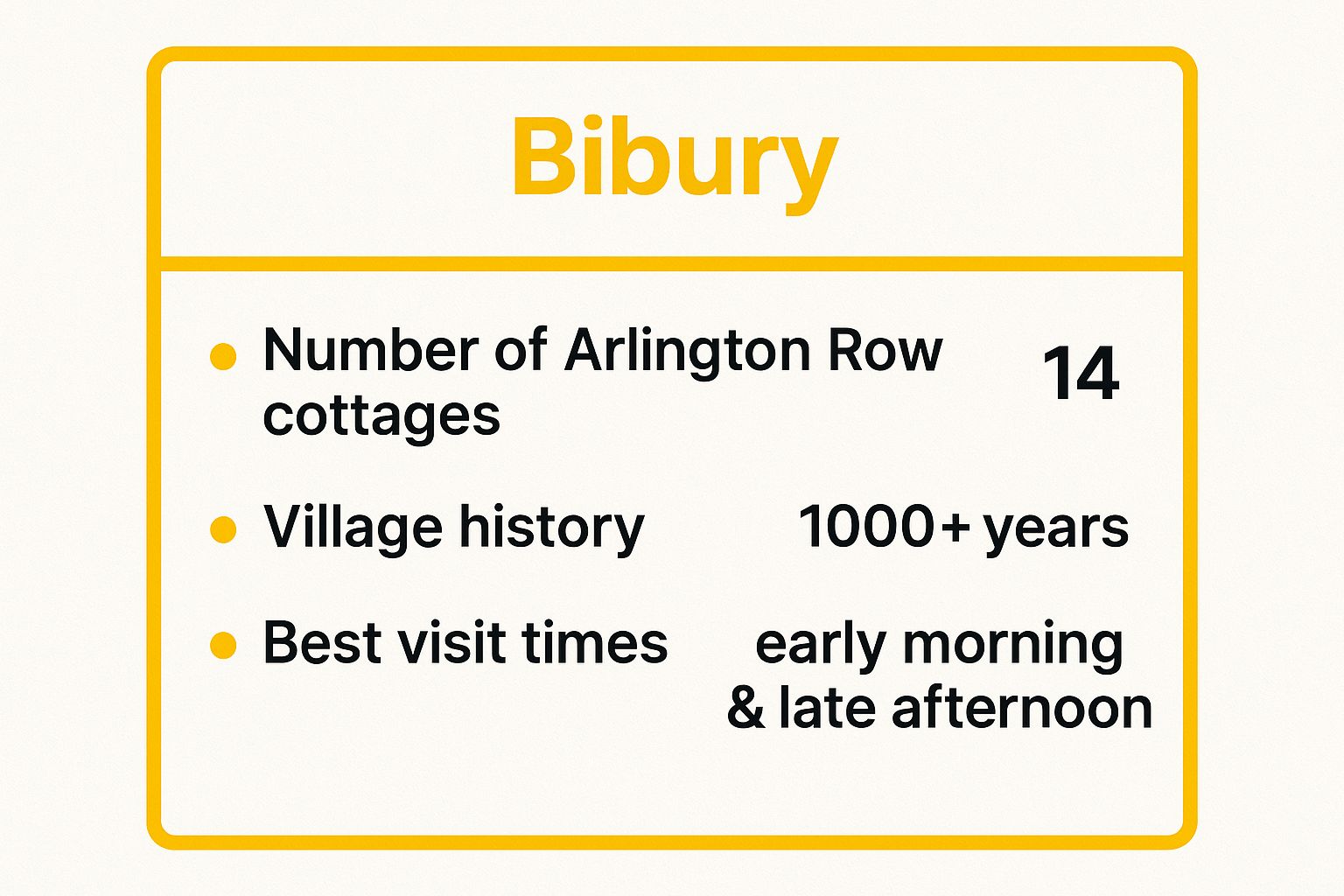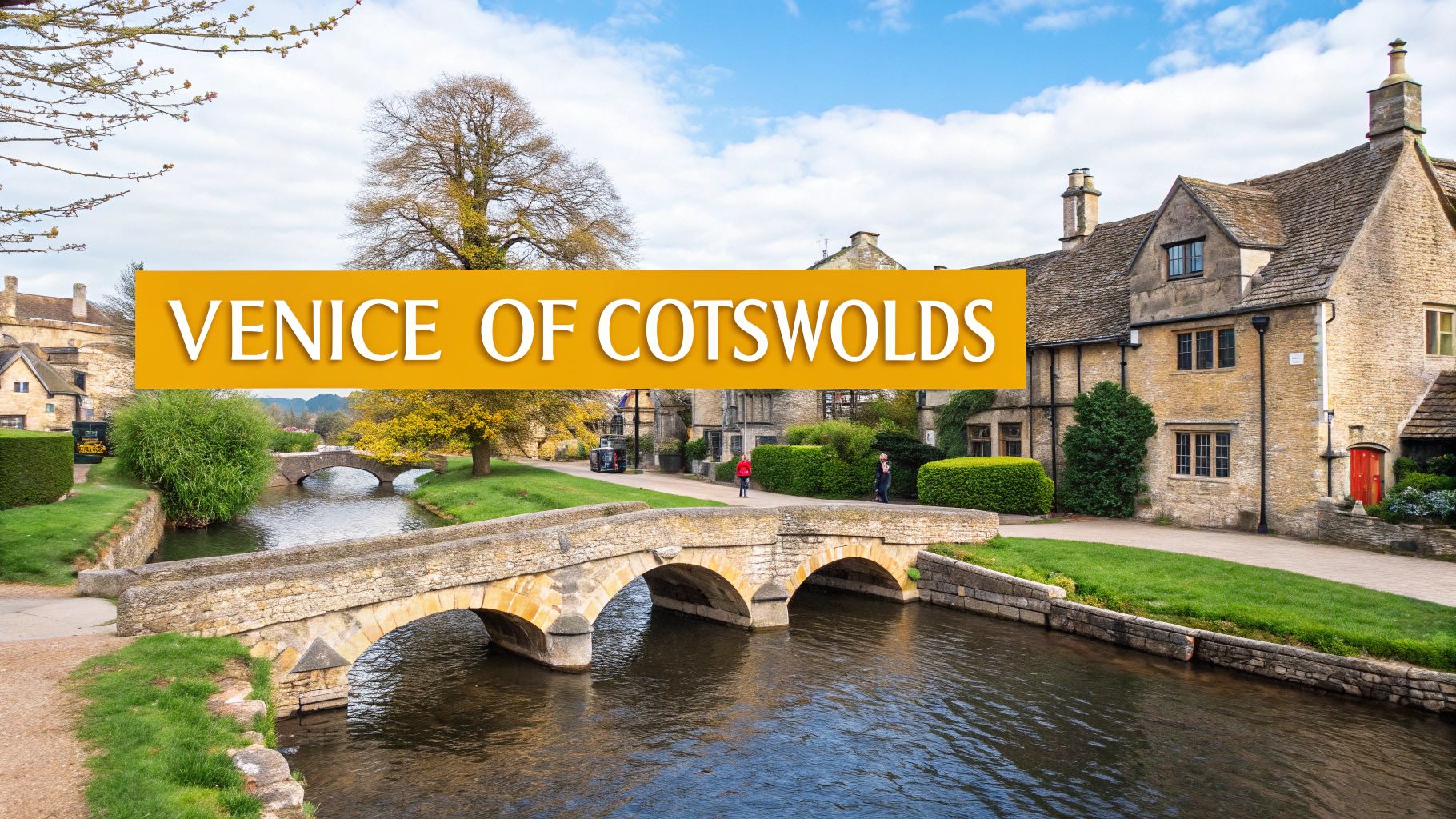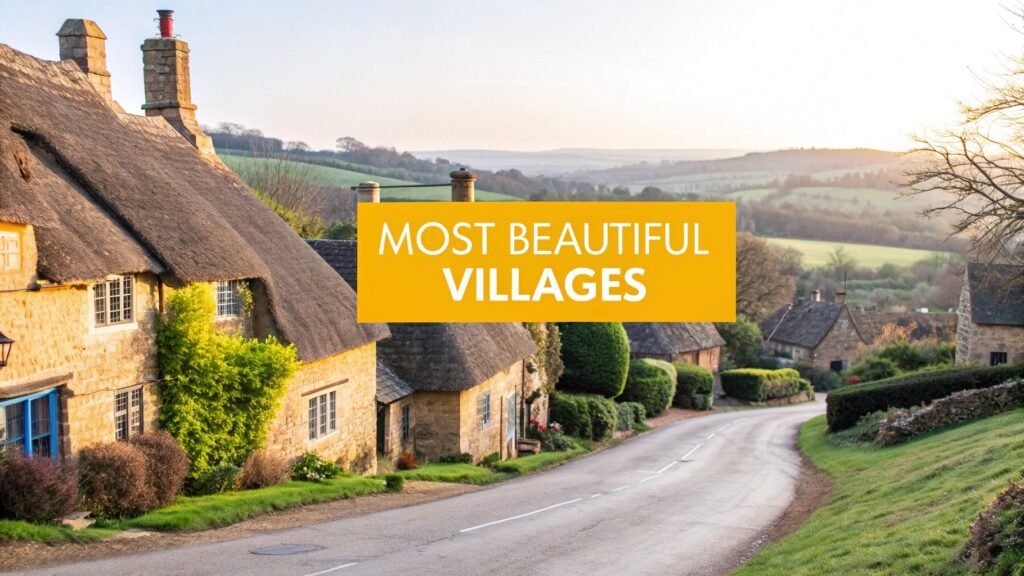England's enduring appeal is not confined to its grand cities or historic monuments. Tucked away in rolling hills and nestled along dramatic coastlines are villages that seem to have paused in time, offering a glimpse into a quieter, more picturesque side of the country. This guide moves beyond the typical tourist trails to explore the stories and scenery behind some of the most beautiful villages England has to offer, from the Cotswolds' honey-coloured cottages to the ancient smugglers' coves of the Cornish coast.
This is not just a list of pretty places. We will provide the essential details needed to transform inspiration into a real journey. For each village, you’ll find key highlights, historical context, and practical travel tips designed for independent travellers. We'll uncover what makes each location truly special, whether it's the medieval timber-framed houses of Lavenham or the riverside charm of Bourton-on-the-Water.
This roundup is crafted for those who prefer to explore at their own pace. We will provide actionable insights to help you plan a memorable self-drive tour, ensuring you can connect with the authentic character of these remarkable locations. Discover the unique architecture, local culture, and stunning landscapes that make these villages national treasures.
1. Bibury, Gloucestershire: The Cotswolds' Crown Jewel
It is no small claim to be called 'the most beautiful village in England', but Bibury has held this unofficial title for over a century. Famed Arts and Crafts leader William Morris bestowed this praise, and a single visit makes it clear why. This quintessential Cotswolds village is a perfectly preserved vision of rural English life, defined by its honey-coloured limestone cottages and the serene River Coln that flows gently through its centre.
Bibury’s international fame stems almost entirely from one iconic, storybook scene: Arlington Row. This slanted row of weavers' cottages, with their steeply pitched roofs, dates back to the 14th century. Originally a monastic wool store, the buildings were later converted in the 17th century into homes for weavers supplying cloth for the nearby Arlington Mill. The scene is so archetypally English that it has graced the inside of UK passports and appeared in films like Bridget Jones's Diary.
Visiting Bibury: A Practical Guide
Beyond the undeniable charm of Arlington Row, the village offers a peaceful escape. Visitors can explore the Saxon-era Church of St. Mary or visit the Bibury Trout Farm, one of Britain's oldest, where you can even catch your own fish. The village is a living postcard, and its enduring appeal makes it one of the most photographed spots in the country.
This summary box highlights key details for planning your visit to one of the most beautiful villages in England.

These details underscore Bibury's deep history and the importance of timing your visit to fully appreciate its tranquil atmosphere.
Actionable Travel Tips
To make the most of your trip and respect the local community, consider these tips:
- Arrive Early or Late: The village is extremely popular. To avoid crowds and capture the best photographs, plan your visit for early morning (before 9 am) or late afternoon (after 5 pm).
- Respectful Parking: Use the designated car park near the trout farm. Parking along the narrow lanes is heavily restricted and should be avoided to prevent congestion and maintain access for residents.
- Combine Your Trip: Bibury is a small village. Pair your visit with other nearby Cotswolds gems like Bourton-on-the-Water or Burford to create a full-day itinerary.
- Best Photo Spot: For the classic shot of Arlington Row, position yourself on the small footbridge that crosses the River Coln.
2. Castle Combe, Wiltshire: A Timeless Film Set
If Bibury is the Cotswolds' crown jewel, then Castle Combe is its perfectly preserved time capsule. Often called 'the prettiest village in England', its stone-built cottages, ancient market cross, and the babbling Bybrook River create a scene so untouched by modernity it feels like stepping onto a film set. In fact, it has been the backdrop for numerous productions, including War Horse and the fantasy film Stardust.
The village's heart is its 14th-century Market Cross, a stone monument that speaks to its history as a thriving wool trade centre. The main street gently curves down to a stone bridge over the Bybrook, providing the iconic photograph that has made Castle Combe famous. Unlike many other popular spots, the village has no overhead wires or TV aerials, a deliberate choice by residents to maintain its historic authenticity. This commitment makes it one of the most unique and beautiful villages in England.
Visiting Castle Combe: A Practical Guide
Castle Combe offers more than just a picture-perfect view. The 13th-century St. Andrew's Church is home to the Castle Combe Clock, one of the oldest working clocks in the country. The village also has a motor racing circuit nearby, offering a surprising contrast to its tranquil streets. The Manor House Hotel provides a touch of luxury with its Michelin-starred restaurant and golf course.
This summary box highlights key details for planning your visit to one of the most beautiful villages in England. These details underscore Castle Combe's medieval heritage and why a thoughtfully planned trip enhances the experience. You can explore this charming village as part of a broader journey through the region with a Taste of South England and Wales tour.
Actionable Travel Tips
To enjoy your visit while respecting the tranquil atmosphere of this residential village, keep these tips in mind:
- Visit Midweek: Castle Combe is a magnet for tourists, especially on weekends. Plan a weekday visit to avoid the largest crowds and coach tours.
- Respect Private Property: The charming cottages are private homes. While taking photos, be mindful not to trespass or peer into windows.
- Explore Beyond the Bridge: Follow the public footpaths leading out of the village for stunning countryside walks through the Bybrook Valley.
- Best Photo Spot: The classic viewpoint is from the bridge at the bottom of the main street, looking back up towards the village. For a quieter shot, explore the lanes branching off the main square.
3. Bourton-on-the-Water, Gloucestershire: The Venice of the Cotswolds
Often dubbed the 'Venice of the Cotswolds', Bourton-on-the-Water is one of England’s most enchanting and popular villages. Its undeniable charm comes from the River Windrush, which flows serenely through the heart of the village, crisscrossed by a series of low, elegant stone footbridges. This idyllic waterside setting, combined with immaculate village greens and classic honey-hued stone architecture, creates a picture-perfect scene that feels both grand and intimate.

Unlike quieter Cotswolds hamlets, Bourton-on-the-Water buzzes with life and offers a variety of unique attractions. Its most famous is the Model Village, a one-ninth scale replica of the village itself, meticulously crafted to include every building, bridge, and even the river. This Grade II listed attraction is a marvel of detail and has captivated visitors for decades. The village also hosts the Cotswold Motoring Museum, making it a fantastic destination for families and those seeking more than just scenic views. This combination of beauty and activity ensures its place among the most beautiful villages in England.
Visiting Bourton-on-the-Water: A Practical Guide
Beyond its main attractions, the village invites leisurely exploration. Visitors can browse independent shops and tearooms lining the riverbanks, enjoy a picnic on the village green, or follow riverside paths for quieter walks. Its blend of natural beauty and visitor-friendly amenities makes it a highlight of any Cotswolds itinerary. A self-drive tour is a fantastic way to explore the region at your own pace, and you can learn more about England self-drive tours that include this iconic stop.
Actionable Travel Tips
To make your visit enjoyable and manage the village's popularity, keep these tips in mind:
- Time Your Attraction Visits: Key sites like the Model Village can have long queues. Aim to visit them first thing in the morning or later in the afternoon to avoid the midday rush.
- Explore Beyond the Centre: The main high street can get very crowded. Wander along the footpaths that follow the River Windrush away from the centre for a more peaceful experience.
- Use Park and Ride: During peak season or weekends, the village car parks fill up quickly. Look for park-and-ride services on the outskirts to avoid traffic and parking stress.
- Best Photo Spot: Stand on one of the central stone bridges, like the one nearest the war memorial, for a classic shot capturing the river, greens, and stone buildings on both sides.
4. Lavenham, Suffolk: A Medieval Time Capsule
Stepping into Lavenham is like walking onto the set of a lavish period drama. Widely regarded as the finest medieval wool town in England, Lavenham boasts an extraordinary collection of over 300 listed buildings. Its streets are a breathtaking spectacle of timber-framed houses, leaning at impossible angles with pastel-coloured plasterwork, offering a direct and tangible link to the immense wealth it commanded in the 15th and 16th centuries.
The village’s prosperity was built on the wool trade, and this history is magnificently preserved in its architecture. The centrepiece is the spectacular National Trust Guildhall of Corpus Christi, a striking white-and-timber building that dominates the Market Place. This iconic structure tells the story of the town's rise and fall. Its crooked, timber-framed charm is so authentic that Lavenham served as a filming location for Harry Potter and the Deathly Hallows and countless other productions, solidifying its place as one of the most beautiful villages in England.
Visiting Lavenham: A Practical Guide
Beyond its famous Guildhall, the entire village is a living museum. A walk down the High Street, Water Street, or Lady Street reveals a succession of historically significant homes, each with its own story. The grand St Peter and St Paul's Church, financed by wealthy wool merchants, stands as a testament to the village's former glory and is one of the finest "wool churches" in the country.
This summary box highlights key details for planning your visit to one of England's most perfectly preserved medieval villages.
These details underscore Lavenham's rich heritage and the importance of allowing ample time to soak in its unique atmosphere.
Actionable Travel Tips
To make the most of your trip and appreciate the village’s unique character, consider these tips:
- Allow a Full Day: Lavenham is deceptively large. To explore its winding streets, browse the independent shops, and visit the Guildhall museum properly, dedicate at least half a day, if not a full one.
- Get the Historical Context: Start your visit at the Guildhall museum. Understanding the history of the wool trade will deeply enrich your appreciation for the buildings you see around you.
- Explore Beyond the High Street: Many visitors stick to the main square. Take a walk around the entire village perimeter to discover hidden lanes and charming, less-photographed cottages.
- Combine Your Trip: Lavenham is a perfect anchor for exploring Suffolk. Pair your visit with a trip to the equally historic village of Long Melford or the market town of Sudbury, both just a short drive away.
5. Robin Hood's Bay, Yorkshire: A Smuggler's Coastal Haven
Clinging dramatically to a steep cliffside on the North Yorkshire coast, Robin Hood's Bay is a village that seems to tumble down to the sea. Its jumble of red-roofed cottages, connected by a labyrinth of narrow, cobbled alleyways and hidden courtyards, creates an atmosphere steeped in history and mystery. This is one of the most beautiful villages in England where the past feels palpably present, from its rich maritime heritage to its notorious smuggling legends.

The village’s unique layout wasn't just for picturesque effect; it was a practical defence against the sea and a perfect network for illicit activities. It's said a bale of silk could be passed from the bottom of the village to the top without ever leaving the houses. This history is proudly displayed in the local museum and felt in the winding streets, which have featured in numerous coastal documentaries and historical dramas.
Visiting Robin Hood's Bay: A Practical Guide
Beyond its smuggling tales, the village offers breathtaking coastal scenery and is a prime location on the Dinosaur Coast for fossil hunting. At low tide, the expansive rocky beach reveals rock pools and ancient secrets, making it a paradise for geologists and curious families alike. The raw, natural beauty and compelling history make it an unmissable stop on any tour of the Yorkshire coast.
This summary highlights the essential details for planning a visit to this historic coastal village.
These details emphasise the village’s unique character and the importance of planning around its dramatic coastal environment.
Actionable Travel Tips
To fully enjoy your visit and navigate the village's unique geography, keep these tips in mind:
- Park and Walk: The village is incredibly steep with very limited vehicle access. Use the large car parks at the top and enjoy the scenic walk down to the bay.
- Check the Tides: Access to the beach and fossil-hunting areas is entirely dependent on the tide. Check the tide times before you visit to avoid being cut off.
- Wear Sensible Shoes: The cobbled streets are uneven and steep. Sturdy, comfortable footwear is essential for exploring the village safely.
- Best Photo Spot: For a classic view of the cottages cascading towards the sea, take your photo from the seawall at the bottom of the bay, looking back up at the village.
6. Polperro, Cornwall: A Harbour Frozen in Time
Tucked away in a steep, wooded valley on the south Cornish coast, Polperro is an enchanting fishing village that seems to have resisted the passage of time. Its character is defined by a jumble of whitewashed cottages clinging to the hillsides, connected by a labyrinth of impossibly narrow, winding lanes that all lead down to a picturesque, sheltered harbour. The village’s traffic-free centre preserves its authentic atmosphere, making it a genuine escape into Cornwall's maritime past.
Polperro's story is inextricably linked to the sea, a history coloured by both legitimate fishing and clandestine smuggling. The tiny, historic harbour, brimming with colourful boats, remains the village's beating heart. The surrounding cliffs and coastal scenery have long inspired artists and writers, who flock here to capture its raw, dramatic beauty. This artistic heritage, combined with its preserved fishing village character, easily makes Polperro one of the most beautiful villages in England.
Visiting Polperro: A Practical Guide
Beyond its undeniable visual appeal, Polperro invites exploration. Visitors can delve into its smuggling history at the Polperro Harbour Heritage Museum or simply lose themselves in the charming, cobbled streets. The South West Coast Path runs directly through the village, offering breathtaking walks to nearby Talland Bay or Looe, with stunning views of the rugged coastline.
Actionable Travel Tips
To fully experience Polperro and respect its unique environment, keep these tips in mind:
- Park and Walk: The village centre is largely pedestrianised. Use the main car park at the top of the village and enjoy the scenic walk down, or use the seasonal park-and-ride tram service.
- Visit Early or Late: Polperro is a magnet for visitors, especially in summer. Arrive before 10 am or after 4 pm to experience the harbour at its most tranquil and capture the best light for photography.
- Taste the Local Catch: The village is renowned for its fresh seafood. Be sure to visit a local pub or restaurant to try dishes made with fish caught that very day by the Polperro fleet.
- Best Photo Spot: For a classic panoramic view of the harbour and the village nestled in the valley, take the short, steep walk up Chapel Cliff on the eastern side of the harbour.
7. Chipping Campden, Gloucestershire: The Elegant Wool Town
Chipping Campden stands as a magnificent testament to the wealth of the medieval wool trade. Its elegant, terraced High Street, gracefully curving through the town centre, is widely considered one of the finest in England. Unlike some of its smaller neighbours, Chipping Campden offers the feel of a sophisticated market town while retaining the undeniable charm and architectural harmony that makes it one of the most beautiful villages in England.
The town’s history is written in its golden Cotswold stone. The centrepiece is the iconic Market Hall, an ornate structure with open arches built in 1627 by Sir Baptist Hicks to provide shelter for local traders. This landmark, along with the grand "wool church," St. James', with its impressive perpendicular architecture, showcases the prosperity that shaped the town. Today, Chipping Campden is also celebrated as the official start and endpoint of the 102-mile Cotswold Way National Trail, attracting walkers and hikers from around the world.
Visiting Chipping Campden: A Practical Guide
Beyond its famous High Street, Chipping Campden invites exploration of its quiet side lanes, or "closes," which reveal hidden almshouses, charming gardens, and historic workshops. The town was a hub for the Arts and Crafts movement, a legacy that continues in its numerous galleries and artisan studios. It serves as an excellent base for exploring the northern Cotswolds, providing a perfect blend of historic grandeur and tranquil rural access.
The town's unique character is shaped by its rich architectural heritage and its role as a key gateway to one of Britain’s most beloved walking trails. This combination of culture and nature secures its place on any list of England's premier villages.
Actionable Travel Tips
To fully experience Chipping Campden’s unique atmosphere and history, keep these suggestions in mind:
- Explore Beyond the High Street: Wander down the narrow alleyways and side streets like Sheep Street to discover quieter, equally beautiful parts of the town and appreciate the local architecture.
- Start the Cotswold Way: Even if you don't plan to walk the full 102 miles, you can start the trail from the marker stone in the town centre and enjoy a short, scenic walk to Dover's Hill for panoramic views.
- Visit St. James' Church: Don't just admire it from afar. Step inside to see the magnificent brasses, the grand nave, and the intricate craftsmanship that earned it the "wool church" nickname.
- Use as a Touring Base: Chipping Campden's location makes it an ideal hub. Plan day trips to nearby villages like Broadway, Snowshill, and Stanton to explore the wider northern Cotswolds region.
Top 7 Most Beautiful English Villages Comparison
| Village | 🔄 Implementation Complexity | ⚡ Resource Requirements | 📊 Expected Outcomes | 💡 Ideal Use Cases | ⭐ Key Advantages |
|---|---|---|---|---|---|
| Bibury, Gloucestershire | Moderate (managing crowds, access) | High (parking, accommodation) | High visitor satisfaction with photogenic settings | Historic sightseeing, photography, walking | Iconic cottages, rich history, picturesque river views |
| Castle Combe, Wiltshire | Moderate (small scale, preservation) | Moderate (limited facilities) | Authentic medieval village experience | Quiet tourism, historical exploration | Well-preserved medieval architecture, peaceful setting |
| Bourton-on-the-Water, Gloucestershire | Moderate-high (managing attractions) | High (multiple tourist facilities) | High family-friendly engagement and visitor numbers | Family outings, interactive attractions | Unique model village, multiple attractions, scenic river |
| Lavenham, Suffolk | High (preservation, large heritage) | Moderate (limited amenities) | Deep historical insight and educational value | Medieval heritage tours, architecture study | Exceptional medieval buildings concentration |
| Robin Hood's Bay, Yorkshire | High (terrain challenges) | Moderate (parking, trail maintenance) | Strong coastal and fossil-hunting appeal | Coastal walks, fossil hunting, maritime history | Dramatic cliffs, authentic fishing village atmosphere |
| Polperro, Cornwall | Moderate-high (access & preservation) | Moderate (parking/access control) | Authentic fishing village experience with coastal charm | Coastal exploration, seafood tourism | Working harbor, rich maritime heritage |
| Chipping Campden, Gloucestershire | Moderate (heritage maintenance) | Moderate (limited lodging) | Balanced historical and outdoor experience | Walking trails, heritage tourism | Architectural coherence, starting point for trails |
Planning Your Journey Through England's Finest Villages
From the honey-hued cottages of Bibury to the dramatic, winding descent into Robin Hood's Bay, our journey has revealed just a handful of the treasures scattered across the English countryside. Each village, whether it’s the picture-perfect Castle Combe nestled in Wiltshire or the medieval time capsule of Lavenham in Suffolk, offers a distinct and unforgettable experience. These are not merely scenic stops; they are living communities, each with a unique story etched into its ancient stones, crooked timbers, and cobbled lanes.
We have seen how the Cotswolds present a quintessentially English idyll, with destinations like Bourton-on-the-Water and Chipping Campden showcasing elegant architecture and a serene, pastoral charm. In contrast, the Cornish coast gives us the rugged, maritime spirit of Polperro, where smugglers’ tales seem to echo in the narrow alleys. This incredible diversity is the true magic of exploring the most beautiful villages England has to offer. The common thread is a powerful sense of place and a deep connection to history, landscape, and tradition.
Crafting Your Own English Village Itinerary
Embarking on a journey to discover these villages is about more than just ticking names off a list. The real adventure lies in the connections you make between them, the scenic drives through rolling hills, and the unexpected discoveries along the way. Planning a multi-day tour allows you to fully immerse yourself in the experience.
Here are some actionable tips to help you design your perfect trip:
- Cluster by Region: To minimise driving time and maximise immersion, focus on one region at a time. A Cotswolds tour could easily link Bibury, Bourton-on-the-Water, and Chipping Campden, with countless other hamlets to explore in between. Similarly, a trip to Yorkshire could centre on Robin Hood's Bay while also taking in the nearby North York Moors National Park.
- Embrace the Off-Season: While summer offers long days, the spring and autumn months provide a more tranquil experience. Imagine the crisp air and golden light of an October morning in Lavenham or the blooming gardens of Castle Combe in May, all with fewer crowds.
- Go Beyond the Highlights: Use the villages on this list as your anchor points, but allow for spontaneity. The true joy of a self-drive tour is stumbling upon a hidden pub with a roaring fire or a quiet riverside walk that isn’t in any guidebook.
By thoughtfully planning your route, you transform a simple holiday into a curated exploration of England's heritage. The journey itself becomes as rewarding as the destinations, offering a profound sense of discovery and a lasting appreciation for the enduring charm of these remarkable places. Your unforgettable English village adventure is waiting.
Ready to explore England’s idyllic countryside without the stress of planning? The experts at BTOURS specialise in crafting bespoke self-drive itineraries that connect you with the most beautiful villages England has to offer, handling all the details so you can simply enjoy the drive. Discover your perfect English road trip at BTOURS and start your adventure today.



